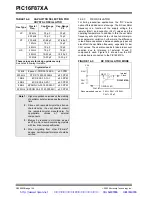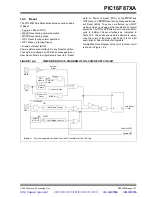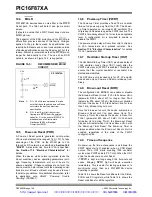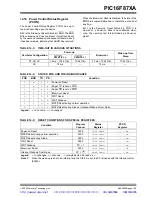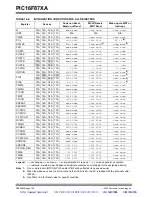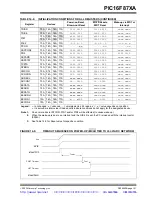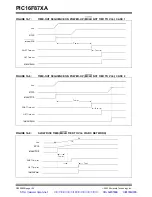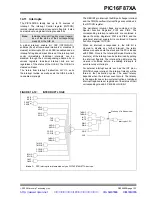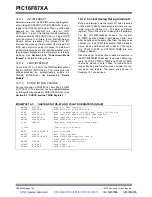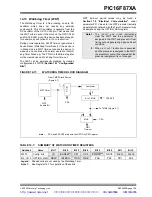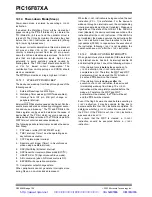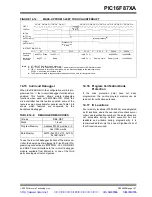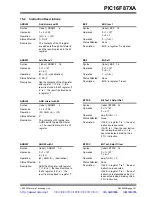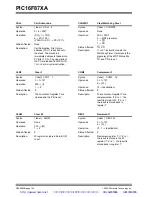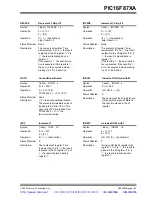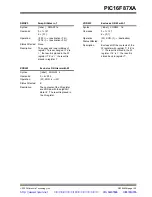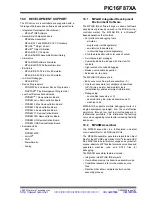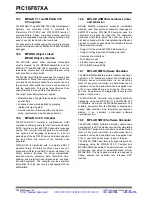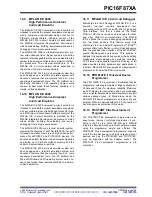
PIC16F87XA
DS39582B-page 156
2003 Microchip Technology Inc.
14.14 Power-down Mode (Sleep)
Power-down mode is entered by executing a
SLEEP
instruction.
If enabled, the Watchdog Timer will be cleared but
keeps running, the PD bit (Status<3>) is cleared, the
TO (Status<4>) bit is set and the oscillator driver is
turned off. The I/O ports maintain the status they had
before the
SLEEP
instruction was executed (driving
high, low or high-impedance).
For lowest current consumption in this mode, place all
I/O pins at either V
DD
or V
SS
, ensure no external
circuitry is drawing current from the I/O pin, power-
down the A/D and disable external clocks. Pull all I/O
pins that are high-impedance inputs, high or low
externally, to avoid switching currents caused by
floating inputs. The T0CKI input should also be at V
DD
or V
SS
for lowest current consumption. The
contribution from on-chip pull-ups on PORTB should
also be considered.
The MCLR pin must be at a logic high level (V
IHMC
).
14.14.1
WAKE-UP FROM SLEEP
The device can wake-up from Sleep through one of the
following events:
1.
External Reset input on MCLR pin.
2.
Watchdog Timer wake-up (if WDT was enabled).
3.
Interrupt from INT pin, RB port change or
peripheral interrupt.
External MCLR Reset will cause a device Reset. All other
events are considered a continuation of program execu-
tion and cause a “wake-up”. The TO and PD bits in the
Status register can be used to determine the cause of
device Reset. The PD bit, which is set on power-up, is
cleared when Sleep is invoked. The TO bit is cleared if a
WDT time-out occurred and caused wake-up.
The following peripheral interrupts can wake the device
from Sleep:
1.
PSP read or write (PIC16F874/877 only).
2.
TMR1 interrupt. Timer1 must be operating as an
asynchronous counter.
3.
CCP Capture mode interrupt.
4.
Special event trigger (Timer1 in Asynchronous
mode using an external clock).
5.
SSP (Start/Stop) bit detect interrupt.
6.
SSP transmit or receive in Slave mode (SPI/I
2
C).
7.
USART RX or TX (Synchronous Slave mode).
8.
A/D conversion (when A/D clock source is RC).
9.
EEPROM write operation completion.
10. Comparator output changes state.
Other peripherals cannot generate interrupts since
during Sleep, no on-chip clocks are present.
When the
SLEEP
instruction is being executed, the next
instruction (PC + 1) is prefetched. For the device to
wake-up through an interrupt event, the corresponding
interrupt enable bit must be set (enabled). Wake-up is
regardless of the state of the GIE bit. If the GIE bit is
clear (disabled), the device continues execution at the
instruction after the
SLEEP
instruction. If the GIE bit is
set (enabled), the device executes the instruction after
the
SLEEP
instruction and then branches to the inter-
rupt address (0004h). In cases where the execution of
the instruction following
SLEEP
is not desirable, the
user should have a
NOP
after the
SLEEP
instruction.
14.14.2
WAKE-UP USING INTERRUPTS
When global interrupts are disabled (GIE cleared) and
any interrupt source has both its interrupt enable bit
and interrupt flag bit set, one of the following will occur:
• If the interrupt occurs before the execution of a
SLEEP
instruction, the
SLEEP
instruction will
complete as a
NOP
. Therefore, the WDT and WDT
postscaler will not be cleared, the TO bit will not
be set and PD bits will not be cleared.
• If the interrupt occurs during or after the
execution of a
SLEEP
instruction, the device will
immediately wake-up from Sleep. The
SLEEP
instruction will be completely executed before the
wake-up. Therefore, the WDT and WDT
postscaler will be cleared, the TO bit will be set
and the PD bit will be cleared.
Even if the flag bits were checked before executing a
SLEEP
instruction, it may be possible for flag bits to
become set before the
SLEEP
instruction completes. To
determine whether a
SLEEP
instruction executed, test
the PD bit. If the PD bit is set, the
SLEEP
instruction
was executed as a
NOP
.
To ensure that the WDT is cleared, a
CLRWDT
instruction should be executed before a
SLEEP
instruction.
http://www.xinpian.net
提供单片机解密、IC解密、芯片解密业务
010-62245566 13810019655





